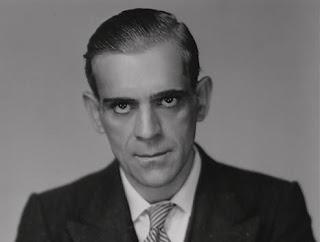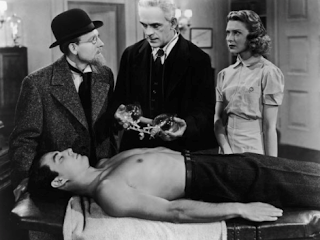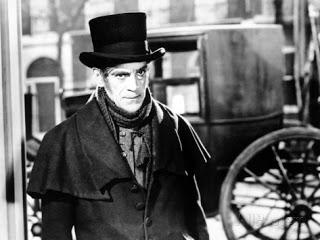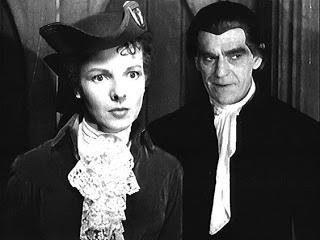 Turner Classic Movies recently aired a day-long tribute Boris Karloff, the cadaverous horror star. His iconic roles as Universal's Frankenstein and The Mummy were merely popular highpoints in a five decade career. Today we'll examine three of his lesser-known roles.
Turner Classic Movies recently aired a day-long tribute Boris Karloff, the cadaverous horror star. His iconic roles as Universal's Frankenstein and The Mummy were merely popular highpoints in a five decade career. Today we'll examine three of his lesser-known roles. The Man They Could Not Hang (1939, Nick Grinde)

"Always remember I offered you life, and you gave me death!"
The Man They Could Not Hang (1939) was the first of several cheapies Karloff made for Columbia in the late '30s and early '40s. Karloff does his best to sell a silly, insubstantial story.Dr. Henryk Savaard (Boris Karloff) experiments with an artificial heart. Interrupted while reviving his assistant, Savaard is charged with murder and executed. Months later, the Judge (Charles Trowbridge) and others involved in the case attend a meeting, where they find Savaard has been revived by his device, plotting an elaborate revenge.
Competently directed by journeyman Nick Grinde, The Man They Could Not Hang makes little of its interesting premise. Grinde devotes nearly half of the film to Savaard's experiments and trial, with the doctor hectoring the idiots who don't appreciate his brilliant invention. Karloff relishes his florid, sneering speeches, along with his triumphant return later on. Movie scientists never grasp that lectures on morality work best when unaccompanied by murder.
Eventually, Hang settles into a Ten Little Indians format, with Savaard's victims murdered one at a time as the Doctor seals himself in an attic - a hiding place easily found by his daughter (Lorna Gray). This set-up creates a modicum of suspense, especially when a repentant Savaard tries using his device one last time, but few opportunities for terror. Eventually, Savaard destroys his mechanical heart; we fade to black, queering whatever message he intended.
The Body Snatcher (1945, Robert Wise)

"When we dislike a friend of ours, we dissect him!"
Karloff worked more fruitfully with Val Lewton, master of B movies. Aside from the stolid Isle of the Dead (1945), their collaborations are gems. The Body Snatcher (1945) is a classy period chiller that packs a lot into a 77 minute runtime.Respected Doctor Wolfe MacFarlane (Henry Daniell) runs an Edinburgh medical school circa 1830. Short of specimens for dissection, he enlists cabbie John Gray (Boris Karloff) to exhume recently interred corpses. Their ghoulish racket works swimmingly until MacFarlane's new assistant, Donald Fettes (Russell Wade), enters the picture. Fettes wants to cure a little girl's (Sharyn Moffett) spinal disease, prompting MacFarlane to seek bodies from any source...living or dead.
Director Robert Wise makes remarkable use of minimal resources. As always, Lewton and Wise use atmosphere over obvious chills, with tiny graveyard sets and shadowy streets effectively creepy. The most effective scene is a long shot of a foggy alley, with Gray stalking a street singer (Donna Lee). Her gay music plays over the scene, until he finds his target. A wild carriage ride through a rainstorm adds a more expansive set piece at the climax.
Using a Robert Lewis Stevenson story, Lewton and cowriter Philip Macdonald center their drama on intersections of class, science and morality. Gray is a proletariat monster who defiles graves for profit; he relishes the power he holds over "respectable" Dr. MacFarlane and threatens him with exposure. MacFarlane justifies his grave robbery as scientific progress, becoming blind to his patients' humanity. He can't connect with little Georgina Marsh anymore than corpses, a disconnect which ultimately drives him mad.
Boris Karloff is a gleeful creep, sublimating his plumy voice under a snarling Cockney lisp. He's equally assured murdering dogs or growling pleasantries at "Toddy." Henry Daniell's (The Sea Hawk) self-justifying anguish is equally effective. Russell Wade (The Ghost Ship) is a dopy non-hero with a clanking American accent, uttering half-hearted protests and fretting over his child charge. Bela Lugosi is wasted as an inarticulate helper who unwisely tries to blackmail Gray.
Bedlam (1946, Mark Robson)

Headstrong Nell Bowen (Anna Lee) is mistress to Lord Mortimer (Billy House), a nobleman in Georgian England. Disgusted by a visit to St. Mary's of Bethlehem, an asylum run by cruel Dr. Simms (Boris Karloff), Bowen falls out with Mortimer. Simms convinces Mortimer to commit Nell, who ends up in Bedlam. Quaker Hannay (Richard Fraser) learns of her plight and tries to free her with the help of radical John Wilkes (Leyland Hodges).
Lewton and Mark Robson fill Bedlam with unnerving content. Simms is a petty tyrant abusing his power, believing that "order" requires brutality. He forces them to perform for amused nobles and lie in filthy straw and restrictive cages. He maneuvers himself into Mortimer's favor through his niece (Lewton favorite Elizabeth Russell), who becomes the Lord's consort. Nell's kindness proves far more effective in helping the prisoners, endangering the foundation of Simms' fiefdom.
Lewton provides a hard edge which prevents Bedlam from lapsing into sentimentality. Nell's imprisoned for her broad-mindedness and tart tongue, something which unfortunately caused many real women to suffer similar fates. She becomes a political danger as well, appealing to Wilkes for reform and holding Mortimer to ridicule through a chatty parrot. Despite her muckraking rhetoric, she's still terrified of the inmates until Hannay pushes her towards Christian charity.
The inmates range from the lucid Sidney (Ian Wolfe), a pompous ex-lawyer, to the somnambulistic Dorothea (Joan Newton), who receives icky attention from Simms. Another (Jason Robards Sr.) is an alcoholic writer locked away by his family. Robson and Lewton present them as frightening and occasionally violent, which seems reaction to their ill-treatment as any mental illness. Slowly humanized by Nell's attention, they band together for well-deserved revenge, in a finale mixing Freaks with Edgar Allan Poe.
Robson makes skillful use of the asylum set, revealing the lunatics through a long crane, disquieting crane shots. Key scenes play with the inmate parroting dialog and menacing arms reaching from shadows. A clever visual device uses Hogarth paintings and a character's doodles as exposition, allowing Bedlam to advance without. Robson shoots the inmates' trial with an Expressionist aplomb worthy of M, allowing even Sims to plead his case.
Karloff perfectly plays an amoral heel, wheedling in one scene, coldly menacing the next. Anna Lee nearly upstages him, getting a rare chance to shine as a haughty, compassionate proto-feminist. Richard Fraser provides friendly if bland complement, while Ian Wolfe and Jason Robards Sr. enliven the prison scenes.
Hopefully, we'll get a chance to revisit Karloff's work closer to Halloween. Until then, on to other films.

